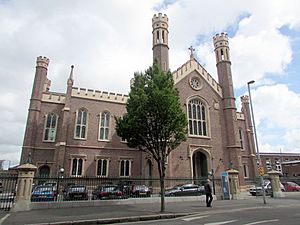Thomas Jackson (architect) facts for kids
Quick facts for kids
Thomas Jackson
|
|
|---|---|

|
|
| Born | 1807 Waterford, Ireland
|
| Died | 1890 |
| Nationality | Irish |
| Occupation | Architect |
| Practice | Thomas Jackson & Sons |
| Buildings | Belfast Hospital for Sick Children |
Thomas Jackson (born in 1807, died in 1890) was a famous Irish architect from the 1800s. He helped design many important buildings in Belfast, giving the city its special look. People said he was the best architect in Belfast during his time. He was known for his work in the Baroque style, which is a grand and detailed way of building.
Contents
Early Life and Family
Thomas Jackson was born in 1807 in Waterford, a city in Ireland. His parents, Anthony Jackson and Elizabeth Pim, were both part of a religious group called the Quakers. Quakers are known for their peaceful beliefs and simple way of life. Thomas Jackson's family had a long history with the Quakers in Ireland, going back to 1654!
Later in his life, Thomas Jackson helped the Quaker community by designing many of their meeting houses in Northern Ireland. These were places where Quakers gathered for worship and community events.
On New Year's Day in 1835, Thomas Jackson married Lydia Newsom Ridgeway. She was also from the Quaker community in Waterford. They had two sons together: Anthony Thomas Jackson and William Ridgeway Jackson.
Architectural Career
Thomas Jackson started his journey as an architect by training with George Dymond in Bristol, England. This was like an internship where he learned the skills of the trade. In 1829, he moved to Ulster in Ireland. There, he worked with another architect named Thomas Duff in Newry.
Jackson was put in charge of Duff's new office in Belfast. He stayed in this role until 1835, when he decided to start his own architecture business. One of his most well-known projects from this time was the Old Museum building. He designed it for the Belfast Natural History and Philosophical Society. He was also an honorary member of this society.
Around 1840, Jackson went back to his hometown of Waterford for a short time. He designed a new bank building at 31 O'Connell Street. This bank was finished around 1845. It was later planned to become the Waterford Gallery of Art.
Working with His Sons
Around 1867, Thomas Jackson's sons, Anthony and William, joined his business. They started working together under the name Thomas Jackson & Sons. However, Anthony left the company around 1870 to follow his own interests. William continued to work with his father for about ten more years. After that, William moved to Australia. Thomas Jackson designed very few buildings after his son William left.
Thomas Jackson was mainly known for designing homes. However, he also worked on many other types of buildings. These included commercial buildings (like shops and offices), educational buildings (like schools), industrial buildings (like factories), and churches. For example, he designed the large Cliftonville housing area. He was also the main architect for Ulster Bank and for the Banbridge, Lisburn & Belfast Junction Railway.
Famous Buildings Designed
Thomas Jackson is personally credited with designing 114 buildings in total. Here are some great examples of the work done by Thomas Jackson and his sons:
- Arnotts Warehouse, Belfast
- Belfast Hospital for Sick Children
- Clifton Villas, Belfast
- Craigavon House
- Glenmachon House, Belfast
- Graymount House, Belfast
- Natural History Museum, Belfast
- St. George's Building, Belfast
- St. Malachy's Church, Belfast
- 31 O'Connell Street, Waterford
Images for kids









